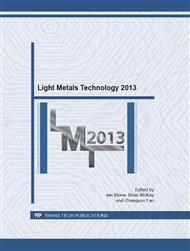p.451
p.456
p.461
p.466
p.471
p.476
p.481
p.486
p.491
Effect of Selected Alloying Elements on Aluminium Physical Properties and its Effect on Homogenization after Casting
Abstract:
Modern technology for near net shape aluminium alloy flat rolled products includes twin roll casting, cold rolling and heat treatment. The technology is most common for 1XXX, 3XXX and 8XXX aluminium alloys. In fact, this technology of cold forming is applied to materials with as cast structure which may in some cases limit formability during rolling. As a consequence, the fundamental operation for high quality products is a well chosen homogenization process of material after casting. During the homogenization of 8XXX alloys after twin roll casting, important changes in electrical conductivity of the material have been reported in the literature. Possibly, the observed effects are connected with the migration of alloying element atoms in the microstructure. This study presents the influence of selected alloying elements on the electrical conductivity and mechanical properties of aluminium. On this basis, it is possible to analyse the effect and level of diffusion of alloying elements from particles to matrix and from matrix to particles during homogenization of 8XXX alloys in as cast temper. Additional comparison of experimental results with theoretical considerations via Nordheim’s rule was also analyzed in this study.
Info:
Periodical:
Pages:
471-475
Citation:
Online since:
July 2013
Authors:
Price:
Сopyright:
© 2013 Trans Tech Publications Ltd. All Rights Reserved
Share:
Citation:


